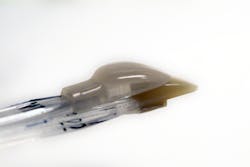The biomimetically driven restorative dental practice
I remember when I graduated from dental school in 1989, I was not impressed with the current techniques and armamentarium; amalgam restoration, cast post and core, and crown and bridge were not particularly appealing to me. These approaches simply did not feel right to me. I profoundly questioned my career path and contemplated my future as I was completely unsatisfied with my clinical performance, which at the time employed these traditional techniques and resulted in sound yet ordinary and unsatisfactory clinical outcomes.
I was becoming increasingly discouraged and disappointed and was ready to abandon my professional path when I was given the opportunity to work with two master ceramists—Claude Sieber in Basel, Switzerland, and my brother Michel, who opened his own laboratory in 1992 in Montreux, Switzerland.
Concurrently, I discovered there was another way, something radically different that would require quite a leap of faith. In 1984, an article impacted me like a gospel for the biomechanics of the tooth: "Cusp reinforcement by the acid-etch technique” by Morin et al.1 It demonstrated that bonding to enamel alone was able to reinstate cusp rigidity in a way that would allow me to reinforce the tooth without invasive preparation. This was immediately followed by the realization that adhesive dentistry combined with the mastership of a dental ceramist was a monumental recipe and in retrospect, was going to shape and alter the next 10 years of my career. It culminated with a PhD and my first book, Bonded Porcelain Restorations, in 2002.2
Today’s dentistry must be driven by BRD
Skipping forward, today we’ve all heard about esthetic dentistry, cosmetic dentistry, adhesive dentistry, minimally invasive dentistry, and the numerous labels describing the discipline of modern restorative dentistry. There is one universal label, however, that encompasses all others because its core definition is foundational to the others: biomimetic restorative dentistry (BRD).3,4 This is “using synthetic methods and materials to mimic a model, a true reference, one that does not change nor evolve with time.”3,4
This model is the dental archetype, the intact natural tooth. There have been numerous attempts to mimic biochemical processes via stem cell research and molecular biology, but none of these efforts, spanning more than 30 years of research, have resulted in a tangible and sustainable development for the restorative practitioner. To date, the only way to restore a tooth with authentic enamel and dentin is to recycle wisdom teeth in a structured innovative process including a CAD/CAM machine.5 The method is elegant and inspired by the biomimetic principle, using resin bonding as a cornerstone.
Many colleagues have used the label “biomimetic dentistry” for marketing purposes, but how many understand the real meaning of the term? For a clinician to have a truly BRD-driven practice, it implies the following tenets:
- Being passionate about and in love with the natural dentition, and regarding intact unrestored teeth and their natural design as the absolute model to further the rumination and understanding of biology, morphology, mechanics, and function.
- Striving for the sole elimination of the diseased tissues and absolute maintenance of healthy tissues, unlike traditional prosthetic approaches that endorse substantial sacrifices of healthy enamel, dentin, and even the pulp in some instances, in the name of retention and resistance form.
- Becoming an expert “bondodontist,” using proven adhesive protocols, and abandoning all concepts based on retention- and resistance-form principles because less is more. In other words, using direct, semi-(in)direct, and indirect adhesive restorations in combination with composite resins, fiber-reinforced materials, and etchable ceramics, depending on the size of the restorations and complexity of the given case.
- Making use of all updated armamentaria, materials, products, and methods that favor minimally invasive approaches: visual aids, magnification, electric and oscillating handpieces, gold standard dentin bonding agents, additive contours, immediate dentin sealing, deep margin elevation, thermo-modified luting, etc. (figure 1).
- Making every decision based on the four essential elements: science, common sense, experience, and the patient.
I have lectured extensively on these topics for the past 30 years, and I’ve seen older colleagues who felt discouraged with our profession come back to life with a newfound passion, feeling refreshed and renewed with love for restorative dentistry because of BRD. I encourage our young colleagues to sync your dental heartbeat with BRD and find a mentor, a true dental “parent,” who will accompany you through your career. That was the case in my life with Professor Urs Belser at the University of Geneva, my alma mater, Professor Bill Douglas at the Minnesota Dental Research Center in Biomaterial and Biomechanics, where I did my PhD research, and my brother, Michel, who has taught me everything about dental technology and ceramics.
My 2002 book with Professor Belser, Bonded Porcelain Restorations, a Biomimetic Approach, focused on the use of bonded porcelain restorations (figure 2).2 I always considered this the most biomimetic restorative treatment in the sense that the beautiful porcelain veneers crafted by a master ceramist are almost permanent and ageless. The work demonstrated that the application of bonded porcelain restorations could be largely expanded based on new bonding protocols, such as the immediate dentin sealing technique and the use of restorative materials as luting agent.
Our latest works, titled Biomimetic Restorative Dentistry, Volumes 1 and 2, reflect on this evolution and review all the materials and protocols needed for dentists who want to reignite their love for the profession with a fresh perspective regarding restorative approaches.3,4 Throughout my professional journey, I’ve been influenced and encouraged by many colleagues, and I can recommend that you too, seek inspiration from this amazing community: the bio-emulation think tank group, the Academy of Biomimetic Dentistry, and the American and European Academies of Esthetic Dentistry, among others. I have seen my students go from mentees to mentors with the successful application of BRD. The rewards of this practice are priceless and encouraging.
To a skeptic, endorsing BRD is initially somewhat counterintuitive due to the meticulous BRD protocols (thorough, rigorous, intricate, precise, and gradual practices) that often go against the current trends of the dental world market (overpromising simplified, convenient, cheaper, and faster practices). According to Romans 12:2: “Do not conform to the pattern of this world but be transformed by the renewing of your mind.” I am hoping that BRD will have this renewing effect on you, your team, and your practice. God bless you.
References
- Morin D, DeLong R, Douglas WH. Cusp reinforcement by the acid-etch technique. J Dent Res. 1984 Aug;63(8):1075-1078. doi:10.1177/00220345840630081401. PMID: 6379008
- Magne P, Belser U. Bonded Porcelain Restorations, a Biomimetic Approach. Quintessence Publishing; 2002.
- Magne P, Belser U. Biomimetic Restorative Dentistry, Volume 1: Fundamentals and Basic Clinical Procedures. Quintessence Publishing; 2021.
- Magne P, Belser U. Biomimetic Restorative Dentistry, Volume 2: Advanced Clinical Procedures and Maintenance. Quintessence Publishing; 2021.
- Schlichting LH, Schlichting KK, Stanley K, Magne M, Magne P. An approach to biomimetics: the natural CAD/CAM restoration: a clinical report. J Prosthet Dent. 2014 Feb;111(2):107-115. Epub December 17, 2013. PMID: 24355511. doi:10.1016/j.prosdent.2013.08.006
Editor's note: This article appeared in the February 2022 print edition of Dental Economics.
About the Author

Pascal Magne, DMD, MSc, PhD
Pascal Magne, DMD, PhD, MSc, is currently the Director of Magne Education at the Center for Education and Research in Biomimetic Restorative Dentistry (CER BRD). He has been widely published, resulting in many awards. He coauthored the book Bonded Porcelain Restorations in the Anterior Dentition—A Biomimetic Approach, with Professor Urs Belser (translated into 12 languages). He was recruited as a full-time tenured faculty at the University of Southern California in 2004, and served as the Don and Sybil Harrington Professor of Esthetic Dentistry until 2022, when Magne and Belser published the second edition of their bestselling book Biomimetic Restorative Dentistry, already translated in nine languages.


